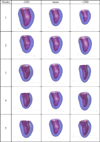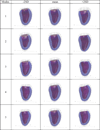Atlas-Based Ventricular Shape Analysis for Understanding Congenital Heart Disease
- PMID: 28082823
- PMCID: PMC5222611
- DOI: 10.1016/j.ppedcard.2016.07.010
Atlas-Based Ventricular Shape Analysis for Understanding Congenital Heart Disease
Abstract
Congenital heart disease is associated with abnormal ventricular shape that can affect wall mechanics and may be predictive of long-term adverse outcomes. Atlas-based parametric shape analysis was used to analyze ventricular geometries of eight adolescent or adult single-ventricle CHD patients with tricuspid atresia and Fontans. These patients were compared with an "atlas" of non-congenital asymptomatic volunteers, resulting in a set of z-scores which quantify deviations from the control population distribution on a patient-by-patient basis. We examined the potential of these scores to: (1) quantify abnormalities of ventricular geometry in single ventricle physiologies relative to the normal population; (2) comprehensively quantify wall motion in CHD patients; and (3) identify possible relationships between ventricular shape and wall motion that may reflect underlying functional defects or remodeling in CHD patients. CHD ventricular geometries at end-diastole and end-systole were individually compared with statistical shape properties of an asymptomatic population from the Cardiac Atlas Project. Shape analysis-derived model properties, and myocardial wall motions between end-diastole and end-systole, were compared with physician observations of clinical functional parameters. Relationships between altered shape and altered function were evaluated via correlations between atlas-based shape and wall motion scores. Atlas-based shape analysis identified a diverse set of specific quantifiable abnormalities in ventricular geometry or myocardial wall motion in all subjects. Moreover, this initial cohort displayed significant relationships between specific shape abnormalities such as increased ventricular sphericity and functional defects in myocardial deformation, such as decreased long-axis wall motion. These findings suggest that atlas-based ventricular shape analysis may be a useful new tool in the management of patients with CHD who are at risk of impaired ventricular wall mechanics and chamber remodeling.
Keywords: CHD; atlas; cardiac; shape analysis; single-ventricle.
Conflict of interest statement
The other authors have no competing interests to declare.
Figures




References
-
- Alfakih K, Plein S, Thiele H, Jones T, Ridgway JP, Sivananthan MU. Normal human left and right ventricular dimensions for MRI as assessed by turbo gradient echo and steady-state free precession imaging sequences. Journal of Magnetic Resonance Imaging. 2003;17:323–329. - PubMed
-
- Brickner ME, Hillis LD, Lange RA. Congenital heart disease in adults - (Second of two parts) New England Journal of Medicine. 2000;342:334–342. - PubMed
-
- Brickner ME, Hillis LD, Lange RA. Congenital heart disease in adults: First of two parts. New England Journal of Medicine. 2000;342:256–263. - PubMed
-
- Cohn JN. Critical review of heart failure: the role of left ventricular remodeling in the therapeutic response. Clin Cardiol. 1995;18:IV4–IV12. - PubMed
-
- Fonseca CG, Backhaus M, Bluemke DA, Britten RD, Chung JD, Cowan BR, Dinov ID, Finn JP, Hunter PJ, Kadish AH, Lee DC, Lima JA, Medrano-Gracia P, Shivkumar K, Suinesiaputra A, Tao W, Young AA. The Cardiac Atlas Project--an imaging database for computational modeling and statistical atlases of the heart. Bioinformatics. 2011;27:2288–2295. - PMC - PubMed
Grants and funding
LinkOut - more resources
Full Text Sources
Other Literature Sources
